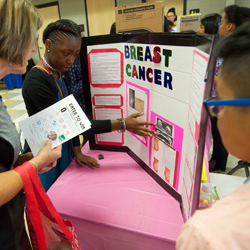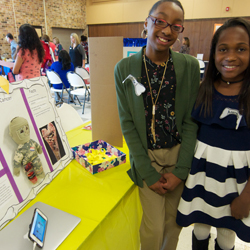- KISD 4 STEM
- Middle School STEM
Cancer Research Outreach
 Seventh-graders sought out complex facts about specific kinds of cancer, interviewed experts and presented their findings in a public health fair.
Seventh-graders sought out complex facts about specific kinds of cancer, interviewed experts and presented their findings in a public health fair.
Project Based Learning, the model in practice at the Killeen ISD Middle School STEM Academy was on display Thursday during a First National Bank employee health fair.
Science teacher Connie Cox said the 48 students she chose to share their presentations adapted well to an unknown environment, overcame technology challenges and learned a ton.
Near the end of the three-hour information fair at the Killeen Community Center, Cox noticed two students at their display about breast cancer continuing to talk about the complex topic. She started to get giddy, realizing the learning was continuing.
The STEM Academy science students worked through the first nine-week grading period researching a particular kind of cancer, mostly varieties that affected someone they knew.
 Students interviewed patients, caregivers, supporters and others connected to the disease.
Students interviewed patients, caregivers, supporters and others connected to the disease.
“We were studying cells and cancer is mutated cells that reproduce at enormous rates,” Cox said. “I wanted to create awareness.”
With many family members diagnosed with many forms of cancer, the science teacher said she was determined that students get a glimpse of lifestyle risks connected to some forms of the disease.
The project, with its required presentation segment and action plan made up the first project for the new academy, which is located at Killeen ISD’s new Roy J. Smith Middle School. Students came up with gifts for cancer patients as part of the action project.
One student pair found out that nine children a day across America are diagnosed with brain cancer, a disease as wide-ranging as the brain that can impact breathing, the heart, personality and numerous other functions.
Katelyn Miller and Joseph Pena researched facts and formed a model of a brain with silicon. They also interviewed a mother of a young adult who died from brain cancer.
“I think this project went really well,” Miller said. “It was fun and it was moving because so many people have so many different kinds of cancer.”
While the brain can repair itself, cancer tumors impair function, Pena said. The disease can be hereditary, but isn’t always and it progresses through stages, he said.
Destiney Stephens and Anayah Tavares found out that bone cancer can form in any bone in the body and can spread throughout the body.
Their presentation included a video animation and x-ray images, as well as pictures and displayed facts. “I talked to a doctor. I thought it was really cool,” Stephens said. “I never knew anything about bone cancer. It was all new.”
Another pair of students researched the method of diagnosis, treatments, symptoms and preventative measures associated with leukemia, a blood cancer.
Exposure to radiation, virus, tobacco use and certain scans have been connected to leukemia, the students said. Leukemia also affects the immune system.
Joanelis Rijos and Dellentino Greene said they found out that the lead robe that dentists and other health care providers use when conducting x-rays protect patients from dangerous radiation.
Research on breast cancer showed that men with the disease often don’t survive because they don’t get checked. Also, risk rises with age and exposure to radiation, pollution, alcohol and tobacco smoke.
Cox said the seventh-graders, all new to the just-opened STEM Academy, are working harder than ever before and she credited family members and community partners for support.
October 19, 2017

